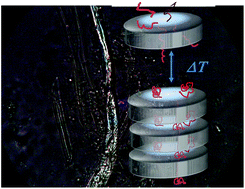当前位置:
X-MOL 学术
›
Polym. Chem.
›
论文详情
Our official English website, www.x-mol.net, welcomes your feedback! (Note: you will need to create a separate account there.)
Reversible hierarchical structure induced by solvation and temperature modulation in an ionic liquid-based random bottlebrush copolymer†
Polymer Chemistry ( IF 4.6 ) Pub Date : 2018-09-06 00:00:00 , DOI: 10.1039/c8py01218k Harsha D. Magurudeniya 1, 2, 3, 4 , Bryan S. Ringstrand 1, 2, 3, 4 , Sönke Seifert 5, 6, 7, 8 , Millicent A. Firestone 1, 2, 3, 4
Polymer Chemistry ( IF 4.6 ) Pub Date : 2018-09-06 00:00:00 , DOI: 10.1039/c8py01218k Harsha D. Magurudeniya 1, 2, 3, 4 , Bryan S. Ringstrand 1, 2, 3, 4 , Sönke Seifert 5, 6, 7, 8 , Millicent A. Firestone 1, 2, 3, 4
Affiliation

|
A solvent and temperature responsive random copolymer having a polyacrylate backbone with emanating ionic liquid side chains of 1-decyl-3-methylimidazolium chloride and 1-(2-carboxyethyl)-3-imidazolium bromide grafted poly-N-isopropylacrylamide (PNIPAM) possessing bottlebrush architecture is synthesized. The bottlebrush copolymer is prepared using an uncommon route that exploits the co-assembly of two amphiphilic ionic liquid acryloyl-based monomers in 30% (w/w) water to form a lyotropic mesophase followed by photo-initiated free radical polymerization. The copolymer adopts a temperature-invariant 2D hexagonal structure as determined by SAXS in the dehydrated (de-swollen) state. The absence of thermoresponsivity is attributed to a combination of confinement coupled with insufficient solvation of the grafted PNIPAM chains. In a water-swollen state (hydrogel), loss in long range translational ordering is observed while short range temperature-dependent ordering dominates. Below the LCST of PNIPAM (<40 °C), disassociated nanoscale discoidal assemblies predominate, as determined by SAXS. At temperatures above the LCST, the particles condense to form thicker circular discs of similar diameter. Polarized optical microscopy shows the formation of 1-D liquid-crystalline fibrillar structures spanning the meso- to micro-length scales. The assembly and disassembly are fully reversible with temperature cycling. This work demonstrates the possibility of achieving self-organization over multiple length scales (panoscopic) to create complex structures from modular components using an external stimulus to control construction.
中文翻译:

离子液体基无规牙刷共聚物中由溶剂化和温度调节引起的可逆分层结构†
一种溶剂和温度响应性无规共聚物,其具有聚丙烯酸酯主链和1-癸基-3-甲基咪唑鎓氯化物和1-(2-羧乙基)-3-咪唑鎓溴化物接枝的聚-N的离子性液体侧链合成了具有牙刷结构的-异丙基丙烯酰胺(PNIPAM)。使用一种不常见的途径制备该洗瓶刷共聚物,该途径利用两种两亲性离子液体丙烯酰基基单体在30%(w / w)水中的共组装形成溶致中间相,然后进行光引发的自由基聚合。该共聚物采用脱水(去溶胀)状态下由SAXS测定的温度不变的二维六边形结构。热响应性的缺乏归因于结合的限制以及接枝的PNIPAM链的溶剂化不足。在水溶胀状态(水凝胶)中,观察到长期翻译有序损失,而短程依赖温度的排序占主导。在PNIPAM的LCST以下(<40°C),解离的纳米级盘状组件占主导地位,由SAXS确定。在高于LCST的温度下,颗粒凝结形成直径相似的较厚圆盘。偏光光学显微镜显示了一维液晶纤维状结构的形成,该结构跨越了中等长度到微米长度的尺度。组装和拆卸可随温度循环完全逆转。这项工作证明了在多个长度尺度(全景)上实现自组织的可能性,从而可以使用外部刺激来控制结构,从而从模块化组件创建复杂的结构。组装和拆卸可随温度循环完全逆转。这项工作证明了在多个长度尺度(全景)上实现自组织的可能性,从而可以使用外部刺激来控制结构,从而从模块化组件创建复杂的结构。组装和拆卸可随温度循环完全逆转。这项工作证明了在多个长度尺度(全景)上实现自组织的可能性,从而可以使用外部刺激来控制结构,从而从模块化组件创建复杂的结构。
更新日期:2018-09-06
中文翻译:

离子液体基无规牙刷共聚物中由溶剂化和温度调节引起的可逆分层结构†
一种溶剂和温度响应性无规共聚物,其具有聚丙烯酸酯主链和1-癸基-3-甲基咪唑鎓氯化物和1-(2-羧乙基)-3-咪唑鎓溴化物接枝的聚-N的离子性液体侧链合成了具有牙刷结构的-异丙基丙烯酰胺(PNIPAM)。使用一种不常见的途径制备该洗瓶刷共聚物,该途径利用两种两亲性离子液体丙烯酰基基单体在30%(w / w)水中的共组装形成溶致中间相,然后进行光引发的自由基聚合。该共聚物采用脱水(去溶胀)状态下由SAXS测定的温度不变的二维六边形结构。热响应性的缺乏归因于结合的限制以及接枝的PNIPAM链的溶剂化不足。在水溶胀状态(水凝胶)中,观察到长期翻译有序损失,而短程依赖温度的排序占主导。在PNIPAM的LCST以下(<40°C),解离的纳米级盘状组件占主导地位,由SAXS确定。在高于LCST的温度下,颗粒凝结形成直径相似的较厚圆盘。偏光光学显微镜显示了一维液晶纤维状结构的形成,该结构跨越了中等长度到微米长度的尺度。组装和拆卸可随温度循环完全逆转。这项工作证明了在多个长度尺度(全景)上实现自组织的可能性,从而可以使用外部刺激来控制结构,从而从模块化组件创建复杂的结构。组装和拆卸可随温度循环完全逆转。这项工作证明了在多个长度尺度(全景)上实现自组织的可能性,从而可以使用外部刺激来控制结构,从而从模块化组件创建复杂的结构。组装和拆卸可随温度循环完全逆转。这项工作证明了在多个长度尺度(全景)上实现自组织的可能性,从而可以使用外部刺激来控制结构,从而从模块化组件创建复杂的结构。



























 京公网安备 11010802027423号
京公网安备 11010802027423号